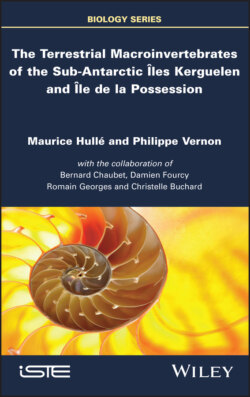Читать книгу The Terrestrial Macroinvertebrates of the Sub-Antarctic Iles Kerguelen and Ile de la Possession - Maurice Hulle - Страница 27
1.7. The terrestrial macroinvertebrates
ОглавлениеTerrestrial macroinvertebrates are represented by seven classes: Clitellata, Gastropoda, Chilopoda, Arachnida, Malacostraca, Collembola and Insecta. The class of Malacostraca includes at least one species of woodlouse, and that of Chilopoda includes at least one centipede species. These two species, whose identification is uncertain, are not presented in this book. Likewise, Collembola and small invertebrates such as mites and tardigrades are not described in this book because we do not have sufficiently recent revisions. The following chapters therefore describe the earthworms, gastropods, spiders and insects currently present on both the Îles Kerguelen and Île de la Possession.
The native species described in the literature have almost all been found during the specific prospecting campaigns that have been carried out since the 2000s. This book therefore gives an account of our current state of knowledge. Similarly, the taxonomy used here takes into account the various revisions that have been published.
In regards to introduced species, only established species have been included. Species seen very occasionally, but which have not succeeded in becoming established, are not considered to be part of the fauna of the two islands. An exception is made for some occasional Lepidoptera that arrive on the islands by natural migration routes. Most of the introduced species have been identified.
For the taxonomic nomenclature, we have used the reference system published by the National Museum of Natural History in Paris1. The identification criteria given here are relatively brief because an identification guide and keys have already been published (Hullé et al. 2018). The arrows on the illustrations of the species correspond to the identification criteria written in blue and italics in the “identification” paragraph. For more direct access to information, we have chosen to present families and species in alphabetical order within each order.
As far as possible, we provide information on the distribution, identification and ecology of each species. The level of information concerning the distribution and biology of species depends on the knowledge we have of them through the literature and field observations reported by various scientists. It is appropriate to pay tribute here to the many people who have collected, identified and studied all of these species. It was not only specialists but also students and field assistants who contributed for a few days, weeks or months to the acquisition of this knowledge. In fact, the permanent scientific programs supported by the “Institut Polaire Français Paul-Émile Victor” (IPEV) make it possible each year to send researchers on summer campaigns and send young volunteers for a full year.
The ability of introduced species to become invasive is a major concern for scientists and managers. In this book, the currently known distribution of each introduced species is given graphically in the form of a presence map. This is the minimum information we have today on the distribution of these species because not all areas have been explored, especially on the Îles Kerguelen which are large.
To complement the morphological approach, molecular characterization of native and introduced species has also been undertaken since 2016. Currently, 162 sequences (gene C01) have been deposited in the Barcode of Life Data System2. This is the STIMT (Sub-Antarctic Terrestrial Invertebrate Molecular Taxonomy) project, which to date includes sequences from 28 native species and 17 introduced species belonging to the different orders present on the two islands.
1 1 https://inpn.mnhn.fr/programme/referentiel-taxonomique-taxref.
2 2 www.boldsystems.org.
